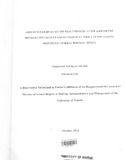| dc.description.abstract | Background: Kenya's policies relating to population, family planning and reproductive health often receive weak or fluctuating levels of adherence. This undermines their implementation. The youth today form the majority of the Kenyan population (National Coordination Agency for Population and Development (NCAPD), 2011). The Adolescent Reproductive Health and Development (ARH&D) policy gives directives and actions to follow in meeting identified ends and goals in the reproductive and developmental needs of the youth (Ministry of Health-Youth Friendly Services (MOH-YFS), 2005). Objectives: The purpose of this research was to evaluate adherence of the health care practitioners (Ht.Ps) to the adolescent reproductive health and development policy at the Garissa Provincial General Hospital, Kenya (GPGH).
Study methods: The research was a cross sectional study with both qualitative and quantitative aspects done in June 2012. The sample comprised of 119 health care practitioners, including 88 nurses, 14 doctors and 17 clinical officers selected randomly. Purposive sampling was done for the adolescents client and 53 were interviewed. Data analysis: Data were collected, cleaned and double entered, coded and counterchecked for accuracy. Quantitative data analysis was then conducted out using the SPSS (statistical package of social scientists) computer programme. Qualitative data analysis was done using computer assisted qualitative data analysis system (CAQDAS). Categorical variables were presented using frequency tables and graphs. Inferential statistics were done by chi square to compare percentages and explore association between ARH&D policy utilization and HCP characteristics.
Results: The HCP utilization rate of the ARH&D was 62.2%. The HCP religious affiliation staffing levels, age, frequency of supervision were some of the factors that influence implementation of the policy. There was a general satisfaction with quality of reproductive health services among the adolescent clientele at GPGH. Severity of infibulations has reduced in severity among the Somali people. Consanguineous marriages of under age girls, drug addiction, poverty, HIV and AIDS and family planning stigmatization are still high in NEP. Conclusion: Adherence to the ARH&D policy was fairly high at the GPGH. There was no ideal YFS at GPGH. The adolescent satisfaction level was high despite some shortcomings with the HCP adverse characteristics, facility deficits, and service management hurdles. | en_US |

